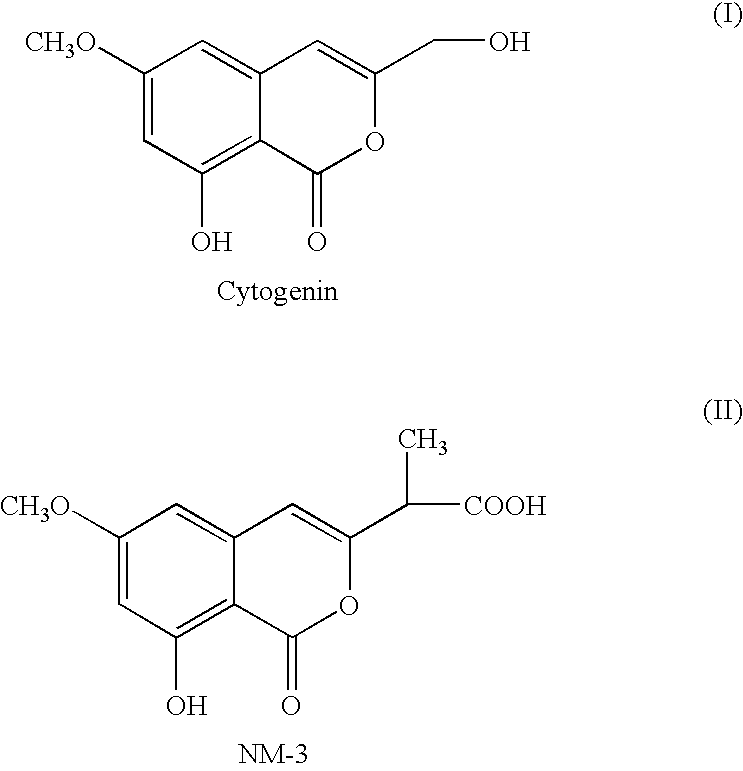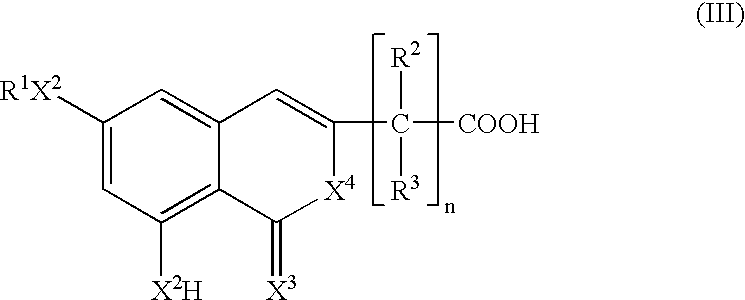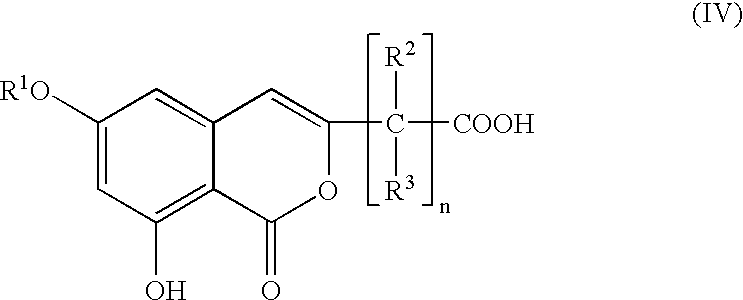Tumor chemopotentiation using isocoumarin derivatives
a technology of isocoumarin and tumor, applied in the field of isocoumarin derivatives, can solve the problems of limited progress in these strategies, affecting the survival rate of patients, and abnormal cell growth, so as to reduce the number of pleural metastatic foci, prolong the survival time, and reduce the growth of solid tumors
- Summary
- Abstract
- Description
- Claims
- Application Information
AI Technical Summary
Benefits of technology
Problems solved by technology
Method used
Image
Examples
example 1
Cytotoxicity of NM-3 Toward Tumor Cells
[0082] To determine the extent to which NM-3 [2-(8-hydroxy-6-methoxy-1-oxo--1H-2-benzopyran-3-yl) propionic acid] inhibited the proliferation of, or was cytotoxic toward, human tumor cells and normal mouse cells, a variety of cell lines were grown in the presence of NM-3. The human cell lines used were K562 (leukemia cells), HT29 (colon tumor cells) HT1080 (reticulum blast sarcoma cells), and MCF7 (breast tumor cells). The mouse cells used were NIH3T3 cells (fibroblasts). All cell lines were cultured in 96-well plates to a density of 2-5.times.10.sup.3 cells / well. Culture medium (RPMI 1640 plus 10% FBS) alone or containing NM-3 at one of several concentrations tested was then added to the cultures which were allowed to grow for an additional 3 days. To assess cell growth, 10 .mu.l of WST-1 reagent (a chromogenic substrate for living cells) was added to each well and incubation continued for 3 hrs at 37.degree. C. Absorbance at 450 nm was then d...
example 2
Effects of NM-3 on Ehrlich Solid Tumor Growth
[0083] To determine the antitumor effect of NM-3 on growth of a solid tumor in vivo, 4.times.106 Ehrlich carcinoma cells per mouse were subcutaneously transplanted into ICR mice (female, 6 weeks old) in the inguinal area. NM-3 was continuously administered via the oral route for 14 days. Tumor weights were then measured on day 15 (Table 2). Whereas tumors from control animals grew to an average size of 1229 mg, tumors from animals treated with 1.25 to 5 mg / kg NM-3 were significantly reduced in size. Tumors from animals receiving the lowest dose of NM-3 (0.63 mg / kg) were also reduced in size but were not significantly different from control values. Thus, NM-3 treatment is associated with a significant reduction in the growth of solid tumors.
2TABLE 2 Antitumor effect of NM-3 on Ehrlich Carcinoma Dose Schedule Mean Tumor Weight Inhibition t-test.sup.a) (mg / kg, p.o.) (days) (mg .+-. S.D.) (%) (.rho.) 0 -- 1229.1 .+-. 549.7 0.0 --5 1 .about. 1...
example 3
Effects of NM-3 on Experimental Tumor Metastasis
[0084] To determine the antitumor effect of NM-3 on metastatic tumor growth, B16-BL6 melanoma cells (2.times.10.sup.4 cells per mouse) were transplanted into BDF1 mice (female, 5 weeks old) via the tail vein. NM-3 was continuously administered via the oral route for 13 days following transplantation of the tumor cells. On day 14, the lungs were excised and fixed, and the metastatic colony numbers were counted. The animals treated with NM-3 (0.08 to 5 mg / kg) experienced a reduction in the number of pleural metastatic foci compared to control animals (Table 3). These results suggest that NM-3 may impart an antitumor effect on the growth of small tumors that arise from tumor metastasis.
3TABLE 3 Dose Schedule Number of lung metastases Inhibition (mg / kg, p.o.) (days) (Mean .+-. S.D.) (Range) (%) 0 -- 84.2 .+-. 19.1 (114-51) 0.0 5.0 1 .about. 13 68.4 .+-. 16.9 (90-47) 18.8 1.25 " 72.6 .+-. 20.6 (106-43) 13.8 0.31 " 64.0 .+-. 23.8 (107-38) 24...
PUM
| Property | Measurement | Unit |
|---|---|---|
| Mass | aaaaa | aaaaa |
| Mass | aaaaa | aaaaa |
| Mass | aaaaa | aaaaa |
Abstract
Description
Claims
Application Information
 Login to View More
Login to View More - R&D
- Intellectual Property
- Life Sciences
- Materials
- Tech Scout
- Unparalleled Data Quality
- Higher Quality Content
- 60% Fewer Hallucinations
Browse by: Latest US Patents, China's latest patents, Technical Efficacy Thesaurus, Application Domain, Technology Topic, Popular Technical Reports.
© 2025 PatSnap. All rights reserved.Legal|Privacy policy|Modern Slavery Act Transparency Statement|Sitemap|About US| Contact US: help@patsnap.com



